Jackfruit Uses, Remedies, Research, Side Effects
Jackfruit – Artocarpus heterophyllus is an Ayurvedic tree used for the treatment of wounds, Bell’s palsy, increasing sperm count, improving the body strength, diarrhea, skin diseases and cases of poisoning.
Latin name- Artocarpus integrifolia Linn., Artocarpus heterophyllus, Artocarpus integer.
Family- Moraceae ( Vata kula)
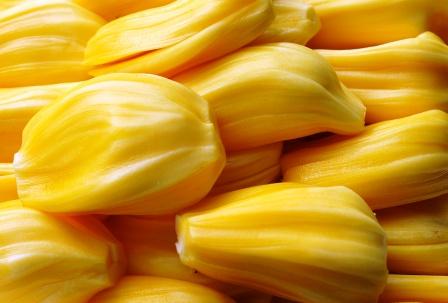
Table of Contents
Vernacular names
Jackfruit Names in different languages:
Hindi name- Katahal, Chakki
English name- Jackfruit
Assamese name- Kathahal, Kathal
Bengali name- Kantal, Kanthal, Kathal
Guajarati name- Panas, Phanas, Katahal
Kannada name- Halasu, Halasina Hannu, Halasina mara. Bigger variety is called heb halasu
Marathi name- Panas, Kathhal, Phanas
Malayalam name- Chakka, Pilavoo, pilavu
Oriya name- Panash
Tamil name- Murasabalam, Chakka, Palamaram , Pilapalam
Telugu name- Panasa chettu
Burmese name – Penine
Konkani name – Ponas
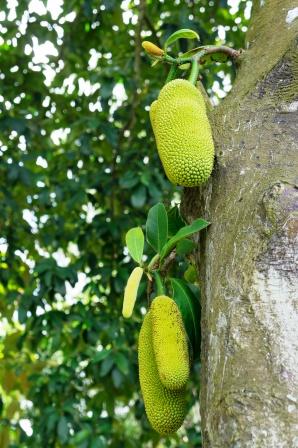
Morphology
Morphology of Artocarpus integrifolia:
Panasa is a big and wide tree, growing to a height of up to 15 to 20 meters. It is found and cultivated all over India in the temperate climate. The bark is thick and broken. Milky latex is found in the tree. The leaves are thick, round to oval in shape, 4-6 inches long and shiny at the upper surface. The flowers are small and are often hidden. The fruits are big, growing to a length of 2-3 feet, having spike-like structures at the outer layer. Ripened fruit is sweet, yellow in color. The seeds are oval to round in shape, covered with a thin layer. Fruits are seen in the month of April to June. Over 100 varieties of Jackfruit are found all over the world and grown for its commercial purpose. The fruits and the seeds are used in many cuisines all over the world.
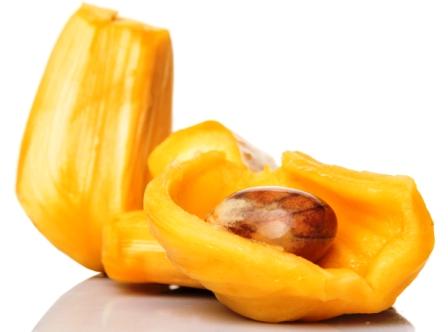
Properties, part used, dosage
Medicinal properties of Jackfruit:
Rasa (Taste) – Madhura (Sweet), Kashaya (Astringent)
Guna (Qualities) – Guru (Heavy), Snigdha (Slimy)
Vipaka – Madhura (Undergoes sweet taste after digestion)
Veerya (Potency) – Sheeta (Cold)
Karma (Actions) – Ripened fruit is Vata pitta shamaka (reduces vitiated vata and pitta dosha)
Part used- Fruit, Leaf, Bark, Latex
Dosage-
Decoction- 50 to 70 ml
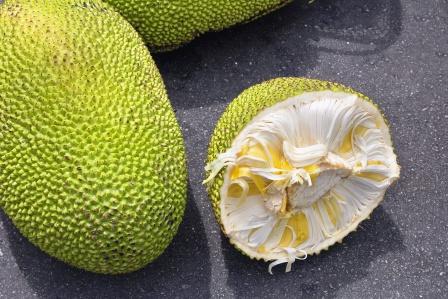
Chemical composition
Chemical composition of Artocarpus heterophyllus:
The leaves and stem have sapogenins in them. The leaves have cycloartenone, cycloartenol and beta- sitosterol. The heartwood of the tree contains flavonoids, artocarpesin and norarto- carpetin. Fruits are a rich source of carbohydrates beta carotene and sucrose. Latex contains cycloartenone, cycloartenol, β-sitosterol, butylospermol; leucine, isoleucine, tyrosine and valiene. Root of the tree contains β- sitosterol, ursolic acid, cycloartenone and artoflavonone.
Uses
Uses of Panasa:
- The ripened fruits of Panasa provide good nourishment and strength to the body: hence can be consumed moderately by persons in need of body strength.
- The latex of the jackfruit helps in wound healing and reduces inflammation near the wounds.
- The leaves of jackfruit are heated slightly after applying with sesame oil and are applied over the cheek region as part of treatment in Bell’s palsy and Trigeminal neuralgia.
- The ripened fruit acts as blood coagulant and is useful to control bleeding in wounds.
- The ripened Jackfruit can be consumed to increase sperm count.
- Decoction of the bark of Panasa is given in a dose of 40- 50 ml to treat diarrhea and skin diseases.
- Decoction of the root and leaf is consumed in a dose of 40-50 ml to treat skin diseases and cases of poisoning due to insect bites.
- Latex from the leaves are applied over the mouth ulcers as part of treatment.
- Latex from the Panasa tree is mixed with vinegar and applied over the area affected with glandular swelling.
- Unripe and ripened fruits of jackfruit along with the seeds are used in many cuisines all over the world.
- Bark of jack fruit is made decoction along with Bhunimba (Andrographis paniculata) and Cumin. This decoction is administered along with Dhanwantaram gulika for the treatment of cough, cold, asthma etc.
Jack Fruit has a Pathya-Apathya to follow, and also wrong combinations (virudha ahar) to pay attention to. Can you please elaborate?
It is a very heavy-to-digest. Hence, taking it after meals, eating it along with other heavy-to-digest foods such as deep fried food, cheese, etc. are not recommended.
Traditional Ayurvedic uses of JackFruit:
Tuvara – astringent
Swadu – sweet taste
Guru – heavy to digest
Vishtambi – causes constipation
Vatala – increases Vata Dosha
Picchila – Sticky, Slimy
Hrudya – acts as cardiac tonic, congenial for heart
Balakrut – improves strength and immunity
Grahi – absorbent, useful in diarrhea, IBS
Durjara – takes a long time to undergo digestion
Indications
Indicated in –
Shrama – tiredness, fatigue
Daha – burning sensation, as in gastritis, neuropathy, burning sensation in eyes etc
Shosha – emaciated
Sanskrit verse
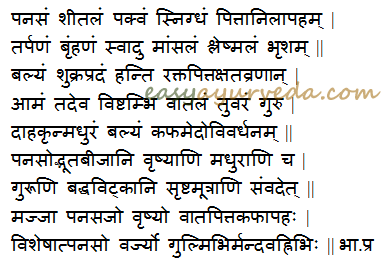
Flower of jackfruit –
Tikta – bitter
Guru – heavy to digest
Vaktra Vishodhana – cleanses oral cavity
Unripe fruit –
Kapha Vardhana – increases Kapha
Medo Vardhana – incrases fat
Vishtambhi – causes constipation
Vatala – increases Vata Dosha
Tuvara – astringent
Dahaghna – relieves burning sensation
Madhura – sweet
Guru – heavy to digest
As per mentioned in Bhojana Kutuhalam, The unripe jackfruit is astringent and sweet in taste and is heavy for digestion. It increases the medhas and sleshma, strengthening, thirst, burning sensation and vitiation of vata and pitta. The partially matured fruit cooked with salt and other ingredients is heavy for digestion and imparts taste.
Ripe Jackfruit –
Sheetala – coolant
Swadu – sweet taste
Tarpana – nourishing
Brimhana – improves weight
Vrushya – aphrodisiac, improves vigor
Mamsala – improves muscle strength
Shleshmala – increases Kapha Dosha
Balya – improves strength and immunity
Snigdha – unctuous, oily
Vatahara – useful in treating disorders of Vata Dosha imbalance such as neuralgia, paralysis, constipation, bloating, etc
According to Bhojana Kutuhalam, The ripe jackfruit is sweet in taste, slimy in nature, heavy for digestion, Is cardio tonic, promotes strength, increases the quantity of semen. It treats fatigue and burning sensation, imparts taste, treats depletion of dhatus and is difficult to digest.
Panasavarta
The flesh of fully ripened jackfruit is spread on a mattress and is allowed to dry in sunlight. It has almost similar properties to that of fruit but is light for digestion due to the processing.
Indicated in –
Raktapitta –Bleeding disorders such as nasal bleeding, heavy periods, etc
Kshata – injury, bleeding
Kshaya – depletion of body tissues, weight loss, tuberculosis
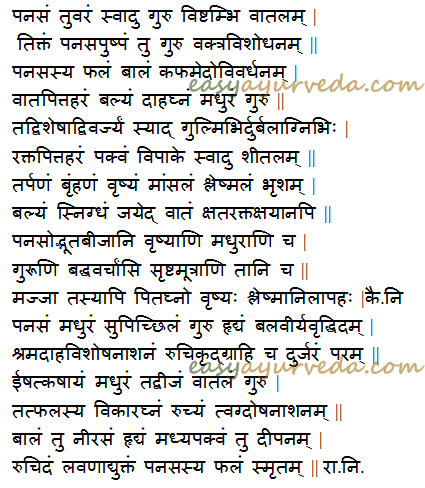
Jack fruit seed uses:
Vrushya – aphrodisiac, improves vigor
Madhura – sweet
Ishat kashaya – slightly astringent
Vatala – increases Vata Dosha
Guru – heavy to digest
Baddha Varchas – causes constipation
Srushtamutra – diuretic
Jackfruit Seed pulp:
Pittaghna – balances Pitta
Vrushya – aphrodisiac, improves vigor
As per Bhojana Kutuhalam the seeds of jackfruit are slightly astringent and sweet in taste, It aggravates vata and is heavy for digestion. It treats the disorders caused by the fruit, It imparts taste and cures skin diseases. The marrow of jackfruit is aphrodisiac and aggravates vata, pitta and kapha dosha. Jackfruit must be avoided by those suffering from gulma and weak digestive fire.
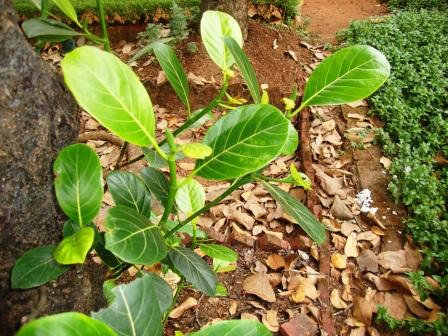
Side effects
Jackfruit side effects:
No adverse effect is known or reported after the normal use of Panasa. But excess intake of fruit can cause increased intestinal movement and diarrhea.
Contra indicated in people suffering from Gulma, Ajeerna (Mandagni – low digestion strength)
Interaction with medicines, supplements
Can this be used while taking Homeopathic medicine?
Yes. This product does not react with homeopathic medicine.
Can this medicine be continued while taking supplements like multivitamin tablets, Omega 3 fatty acids etc?
Yes. Generally, this product goes well with most dietary supplements. However, if you are taking more than one product per day, please consult your doctor for an opinion.
With western medicines
Seek your doctor’s advice if you are taking this product along with other western (allopathic / modern) medicines. Some Ayurvedic herbs can interact with modern medicine.
If both Ayurvedic and allopathic medicines are advised together, then it is best to take Allopathic medicine first, wait for 30 minutes and then take the Ayurvedic medicine.
Research
Research articles related to Artocarpus integrifolia:
Anti- inflammatory action: The antiinflammatory activities of the isolated flavonoids, including cycloartomunin, cyclomorusin, dihydrocycloartomunin, dihydroisocycloartomunin, cudraflavone A, cyclocommunin, and artomunoxanthone and cycloheterohyllin ,artonins A and B , artocarpanone, artocarpanone A and heteroflavanones A , B, and C from Artocarpus communis and A. heterophyllus, were assessed in vitro by determining their inhibitory effects on the chemical mediators released from mast cells, neutrophils, and macrophages.
Anti- oxidant action: The four different extracts of Artocarpus heterophyllus and Manilkara zapota seeds were undertaken and studied for their total phenolics and flavonoids contents, reducing power and antioxidant activity. The antioxidant capacity was studied using DPPH radical scavenging assay and ABTS radical scavenging assay method. . The results revealed that the extracts showed high flavonoids content and reduced potential.
Anti- coagulant effect: The current study focuses on the anticoagulant and antiplatelet activities of aqueous seed extract of Jackfruit (AqSEJ). Anticoagulant effect of AqSEJ was tested using plasma recalcification time, mouse tail bleeding time, Activated Partial Thromboplastin Time (APTT) and Prothrombin Time (PT). Antiplatelet activity was examined by platelet aggregation studies using agonists such as ADP, Collagen and Epinephrine. The AqSEJ enhanced the clotting time of citrated human plasma from 200±10 s to 740±14 s. The anticoagulant activity of AqSEJ was further strengthened by in-vivo mouse tail bleeding assay.
Anti- microbial study: We evaluated the antibacterial activity of the organic extracts (n-hexane, acetone and methanol) from the fruit of Artocarpus heterophyllus Lam. against Staphylococcus aureus,(methicillin-susceptible Staphylococcus aureus [MSSA]). The extract that demonstrated the greatest activity was that of acetone, with a minimum inhibitory concentration (MIC) value of 0.375 mg/ml against S. aureus MSSA.
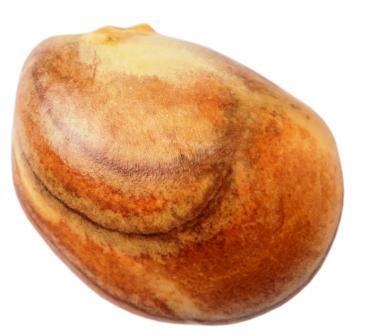
Jack fruit remedies
What are some remedies with jack fruit?
Dr JV Hebbar
Fermented drink prepared from the jack fruit: Charaka samhitha mentions of Phalasava prepared from panasa. Reference: Charaka Samhita, 25/49 To prepare this, jack fruit is crushed to extract juice. 13 liters of this juice is added with 5 kg of rock sugar and 300 grams of Dhataki (Woodfordia fruiticosa) and kept for fermentation. For taste and for better digestion, spices like ginger, cinnamon, cardamom and bayl eaf can be added – 50 grams each. Fermentation may take around 15 – 30 days depending on temperature. It is highly nourishing. Some people may use yeast to induce fermentation.
Does not go well with milk:
Milk with sour fruits, including sour tasting jackfruit is considered a wrong food combination. Reference: Charaka Samhita, Sutrasthana 26/84
Sweet, astringent and nourishing:
Jack fruit Benefits: Ripe fruits of Panasa (jack fruit – Artocarpus Hetrophyllus Lam), Mocha (Musa paraisica Linn) and Rajadana (Mimusops Hexandra Roxb) are sweet accompanied with astringent in taste, cold in potency, unctuous and heavy to digest. As per Charaka Samhita Sutrasthana 27/143
It means it can stay in the stomach for longer time, takes longer hours to undergo digestion. It balances Vata and Pitta dosha and nourishes Kapha Dosha.
For Virechana – Purgation Panchakarma, it is administered along with Saptala and Shankhini. Reference:Charaka Samhita Kaplapasthana 11/ 7
At Easy Ayurveda Hospital, we do sweating treatment with its leaves for the treatment of locked jaw and paralysis.
Watch video below:
Classical categorization
Astanga Samgraha- Madhura skandha – sweet tasting herbs
Bhavaprakasha- Amradi varga
Kaiyyadeva Nighantu- Oushadhi varga
Raja Nighantu- Amradi varga
Saligrama Nighantu- Phala varga
Scientific classification
Kingdom: Plantae
Order: Rosales
Family: Moraceae
Tribe: Artocarpeae
Genus: Artocarpus
Species: A. heterophyllus
Sanskrit synonyms
Sanskrit Synonyms of Katahal – Jackfruit:
Kantaki phala- The fruit has numerous small spikes. – “ Kanta khaha santi asya phalesu ithi’’
Ashaya phala – big fruit
Amashaya Phala- Fruit effect the gastrointestinal tract
Mahasarja, Atibrihat phala- The fruit is big in size
Mridanga phala- Shape of fruit is like mridanga (a musical instrument)
Apushpa phala – Fruits are seen without flowers.
Skanda phala- Fruit is seen in the stem of the tree
Shleshmataka Sadruk patra – The leaves resemble to those of Lasoda – Cordia dichotoma
Garbhakantaka – full of thorns
Phala Vrukshaka – tree yields numerous fruits
Apushpaphala – no flowers, only fruits
Pootaphala – the ripe fruit has peculiar odor
Panasa – “Panyathe sthuyate ithi panasa Parna vyavahare panayate sthuyate ithi va’’
The one which possessesmany qualities and is praised by many is panasa.
SKANDA PHALA – “ Skande phalani jayanthe asya ithi’’
This tree gives fruit on its stem itself .
LAKUCHA:- “ Lakyate aasvadyate ithi lakuchah’’
Due to its sour and sweet taste people like it very much.
AAMASAYA PHALA:- “ Aamaasaya sadrasha phala yukta”
The fruit resembles that of aamasaya.
ATHIBRHAT PHALA :- Fruits are very big .
MRIDABGA PHALA:- Fruit resembles like that of mridanga in shape
Ancient references
- In Atharva Veda in Atharva parisista ( 5.2.1-5) reference to panasa is found .
- It is mentioned in Mahabhasya(1.1.7) and Bana bhatta’s Kadambari 119 and
- Varahamira also mentioned panasa .
- In Charaka samhitha sutra sthana 25th ; 26th ; 27th chapter properties of panasa and its uses are mentioned.
- Fermented drink prepared from the jack fruit: Charaka samhitha mentions of Phalasava prepared from panasa. Reference: Charaka Samhita, 25/49
- In Susrutha Samhitha sutra sthana 46th chapter properties of panasa are mentioned , also mentioned in sutra sthana 9th chapter 4th sloka and in Susrutha Samhitha Chikistha sthana 31st chapter 5th sloka .
- In Astanga Sangraha sutra sthana ,18th chapter while explaining about madhura skandha he mentioned panasa as one among them.
- In Astanga Hridaya 10th chapter of sutra sthana 23rd verse and in 6th chapter 119th verses mentioned panasa.
Jackfruit, canned, syrup pack
Taste – sweet, astringent
Properties – heavy, unctuous
Potency – cold
After digestion taste transformation (Vipaka) – sweet
Effect on doshas
Vata balancing
Pitta balancing
Kapha increasing (more Kapha increasing than raw jackfruit as syrup pack is more concentrated)
Breadfruit ( Artocarpus altilis )
Seeds, breadfruit seeds, raw
Taste – bitter, sweet
Properties – heavy (high calorie)
Potency – Cold
After digestion taste transformation ( Vipaka ) – sweet
Effect on Doshas
Vata balancing
Pitta balancing
Kapha nourishing (immunity improvement)
Seeds, breadfruit seeds, boiled
Taste – bitter, sweet
Properties – not very heavy (boiling makes it lighter)
Potency – Cold
After digestion taste transformation ( Vipaka ) – sweet
Effect on Doshas
Vata balancing
Pitta balancing
Kapha nourishing (immunity improvement)
Seeds, breadnut tree seeds, raw
Taste – bitter, sweet
Properties – heavy
Potency – cold (heavy and cold because it is known to cause digestive difficulties)
After digestion taste transformation ( Vipaka ) – sweet
Effect on Doshas
Vata balancing
Pitta balancing
Kapha increasing
Seeds, breadnut tree seeds, dried
Taste – bitter, sweet
Properties – heavy (as it is dried)
Potency – cold (heavy and cold because it is known to cause digestive difficulties)
After digestion taste transformation ( Vipaka ) – sweet
Effect on Doshas
Vata balancing
Pitta balancing
Kapha increasing
Seeds, breadfruit seeds, roasted
Rasa – bitter, sweet
Guna – not very heavy (roasted)
Veerya – Cold
Vipaka – sweet
Effect on Doshas
Vata balancing
Pitta balancing
Kapha nourishing (less kapha nourishing than raw breadfruit seeds due to decreased heaviness)
Author: Dr.B.K.Prashanth M.D (Ayu), Ph.D
E mail: [email protected]
Click to consult Dr Prashanth BK
Systemic Action (Sthanika Karma)
External – Its latex has Anti anti-inflammatory property and helps for faster wound healing. Can be applied on inflammatory wounds.
Digestive System – Fruit is heavy to digest, so contra indicated in indigestion and other abdominal diseases. Bark decoction has absorbent properties, so indicated in Diarrhea.Circulatory System – Ripened fruit has styptic action.
Reproductive system – Ripened fruit is good to increase sperm count. It has Aphrodisiac action.
Skin – Leaf and bark is indicated in skin disorders.
Satmikarana – It has scraping action on body tissues. Indicated in obesity and related disorders.
Tapakrama – Ripened fruit is balya (Promote strength and body bulk) , It also possesses Anti poisonous action.










2 comments
Ravi
Thanks for the well-written article. I am confused by “Due to its ushna qualities it destroys sukra and netra ” this statement. Isn’t it contrary to what is written in Ayurveda ?
Dr J V Hebbar MD(Ayu)Author
Thanks for pointing out. It is controversial and contradictory. Hence have removed it.